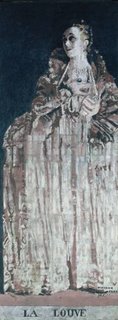
Right: Miss Gwen Ffrangcon-Davies as Isabella of Spain, by Walter Richard Sickert, collection of the Tate Gallery.
If one spends any time in the Tate Britain looking at late 19th and early 20th century British paintings, one will encounter the works of Walter Richard Sickert (1860-1942), currently the front runner in many peoples’ minds to have committed the murders credited to “Jack the Ripper.” Patricia Cornwell, author of the immensely popular Kay Scarpetta series of doorstop crime novels, spent a fortune pursuing her opinion that Sickert was indeed the infamous Whitechapel murderer, and if one credits her detective work and that of experts in forensic science who recently re-examined the evidence still held at New Scotland Yard, the implications seem pretty damning (Portrait of a Killer - Jack the Ripper, Case Closed, by Patricia Cornwell (Berkley, 2002). Not everyone agrees with her conclusions, most particularly surviving relations of the artist. Cornwell quotes someone at Scotland Yard as saying the re-examined evidence would make for an easy conviction, but her detractors quote their own experts as saying the evidence is still far from clear.
Sickert was in his own time a well-known British painter, highly regarded by his contemporaries. He studied under James McNeill Whistler, and was a personal friend of many artists of that period. He is credited with being a “principal conduit of French aesthetics into Britain (http://www.tate.org.uk/),” and with championing both Impressionism and Post-Impressionism when those movements were decidedly unpopular with British art critics. The Tate Britain owns a number of his works, and many more are in other museums and private collections. The late Queen Mother was an avid collector of Sickerts.
As a painter, Sickert seems to have been inordinately fond of browns: browns greyed out and toned down and stepped on with a muddy boot, reds and oranges made brown, blues and greens dirtied down to unpleasantness. Given the undeniable benefit of hindsight, his reds often resemble dried blood. He painted Venice as though there were no yellow in the sunlight, and in many of his plein air works seems to be painting from a shadow into a shadow, with the sun a distant presence barely making itself felt in some part of the sky. A few of his paintings of Dieppe are rather nice, but most are just brown.
I confess I don't get his elevated status in the art world. Most of the Sickerts I’ve seen are either forgettable or worse, not forgettable because they are more than a bit disturbing, especially those which feature people. Not beautiful and disturbing, but butt-ugly and disturbing, in my humble opinion. His portrait of Aubrey Beardsley is agreeable enough (though made up entirely of browns), but his self-portraits don't depict anyone I'd want to know (although a photographic portrait taken perhaps a year previous to his death shows a pleasant-looking bloke who doesn’t look within 15 years of his age, and who might easily be your friend’s grandfather or even your own), and his paintings of women are almost uniformly unpleasant in some way in addition to the palette. His women sometimes have faces too ugly to be from life, such as La Hollandaise, a fleshy nude by moonlight with the face of a nightmare, and Two Women on a Sofa – Le Tose. This is a nice composition of two young women in a relaxed pose, but he could not have found two faces that hideous had he advertised throughout France, so I’m left to suppose the monstrosity came from within. None of these opinions would be admissable as evidence in a court of law, but there you are.
One of Sickert's most fascinating works I’ve seen in person is Miss Gwen Ffrangcon-Davies as Isabella of Spain (see photo above). This is a larger-than-life-size painting of an actress Sickert knew and admired, but I can never get over how inhuman is his portrayal of her. Even making allowances for stage makeup, the woman reminds me of an upright corpse.
So we’ll never know if Walter Sickert was indeed the man who murdered five prostitutes in London and wrote letters to the police and newspapers bragging about it, but we can still look at his art and wonder if it was created by a monstrous psychopathic killer, or if the old man who died in 1942 was no more than a prolific and well-regarded painter who may have had a slight problem with his attitude toward women. Either way he’s beyond harm or the ability to harm at this point, and standing in front of one of his monster-women at the Tate and feeling a slight frisson is – thankfully – as close as any of us is likely to come to the reality of Jack the Ripper.





4 comments:
I'm betting he was Jack. He clearly had some, er, issues.
MISS YOU!!!
I'll be back in the USSA on Wednesday 16 August (that's for the benefit of anyone who wants to blow me up). We definitely gotta get together soon.
Cornwell's book is far from conclusive. Most evidence suggests that Sickert was in France when the crimes were committed.
As I said, I don't have a stake in it one way or another. I did read the book and found it fascinating, though poorly written. As I also said, I'm aware many people disagree with Cornwell's conclusions, but I'm incurably curious about what people say. "Most" meaning how much, and of what or whose evidence?
Post a Comment